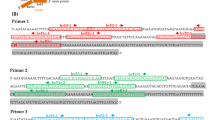Abstract
Wheat dwarf bunt, one of the important international quarantine diseases, is caused by Tilletia controversa. Tilletia caries is a close relative species of T. controversa and the teliospore morphology and genomic structure of T. caries are very similar to those of T. controversa. In order to distinguish between them, a random amplified polymorphic DNA (RAPD) primer-mediated asymmetric-PCR (RM-PCR) was developed to screen differential sequences between the two pathogens. By RM-PCR, a 1,322 bp DNA fragment (PR32) was selected from 18 T. controversa and 29 T. caries strains. The PR32 genes were specific for T. controversa and almost had no homology to T. caries or other fungi in the present database. With primers designed from PR32, all 18 T. controversa strains were amplified, but no bands appeared in 29 T. caries strains by classical PCR. To identify T. controversa rapidly and accurately, SYBR Green I and TaqMan probe real-time PCR were established based on PR32. With TaqMan Real-Time PCR, different T. controversa strains and T. caries strains were detected. The results showed that all T. controversa strains were amplified with Ct from 19–29 and amplified curves were obtained. In contrast, the amplification of all T. caries strains did not show any signals, without Ct and amplified curves. Moreover, the developed TaqMan real-time PCR was used to detect T. controversa from asymptomatic wheat tissues successfully.






Similar content being viewed by others
References
Diatchenko, L., Lau, Y. F., Campbell, A. P., Chenchik, A., Moqadam, F., Huang, B., Lukyanov, S., Lukvanov, K., Gurskava, N., Sverdlov, E. D., & Siebert, P. D. (1996). Suppression subtractive hybridization: a method for generating differentially regulated or tissue-specific cDNA probes and libraries. Proceedings of the National Academy of Sciences of the United States of America, 93, 6025–6030.
Eibel, P., Wolf, G. A., & Koch, E. (2005). Detection of Tilletia caries, causal agent of common bunt of wheat by ELISA and PCR. Journal of Phytopathology, 153, 297–306. doi:10.1111/j.1439-0434.2005.00973.x.
Gang, D. R., & Weber, D. J. (1996). Using random amplified polymorphic DNA to analyze the genetic relationships and variability among three species of wheat smut (Tilletia). Botanical Bulletin of Academia Sinica, 37, 173–180.
Goates, B. J. (1996). Common bunt and dwarf bunt. In R. D. Wilcoxson, & E. E. Saari (Eds.), Bunt and smut diseases of wheat: concepts and methods of disease management (pp. 12–25). Mexico, DF: CIMMYT.
Kim, W. K., Whitmore, E., & Klassen, G. R. (1990). Homologous linear plasmids in mitochondria of three species of wheat bunt fungi, Tilletia caries, T. laevis and T. controversa. Current Genetics, 17, 229–233. doi:10.1007/BF00312614.
Levis, C., Giraud, T., Dutertre, M., Fortini, D., & Brygoo, Y. (1997). Telomeric DNA of Botrytis cinerea: a useful tool for strain identification. FEMS Microbiology Letters, 157, 267–272. doi:10.1111/j.1574-6968.1997.tb12783.x.
McDonald, J. G., Wong, E., & White, G. P. (2000). Differentiation of Tilletia species by rep-PCR genomic fingerprinting. Plant Disease, 84, 1121–1125. doi:10.1094/PDIS.2000.84.10.1121.
Moller, E. M., Bahnweg, G., Sandermann, H., & Geiger, H. H. (1992). A simple and efficient protocol for isolation of high molecular weight DNA from filamentous fungi, fruit bodies, and infected plant tissues. Nucleic Acids Research, 20, 6115–61161. doi:10.1093/nar/20.22.6115.
Money, T., Reader, S., Qu, L. J., Dunford, R. P., Moore, G., & Qu, L. J. (1996). AFLP-based mRNA fingerprinting. Nucleic Acid Research, 24, 2616–2617. doi:10.1093/nar/24.13.2616.
Rusell, B. W., & Mills, D. (1994). Morphological, physiological and genetic evidence in support of a conspecific status for Tilletia caries, T. controversa, and T. foetida. Phytopathology, 84, 576–582. doi:10.1094/Phyto-84-576.
Schaad, N. W., & Frederick, R. D. (2002). Real-time PCR and its application for rapid plant disease diagnostics. Canadian Journal of Plant Pathology, 24, 250–258.
Shen, L. S., & Zhu, L. H. (1998a). Gnetic mapping of the rice telomeric regions through PCR. Acta Genetica Sinica, 25, 508–516.
Shen, L. S., & Zhu, L. H. (1998b). Direct PCR-based genetic mapping of rice telomeric repeat associated sequences. Genome, 41, 193–198. doi:10.1139/gen-41-2-193.
Shi, Y. L., Loomis, P., Chrsitian, D., Carris, L. M., & Leung, H. (1996). Analysis of the genetic relationships among the wheat bunt fungi using RAPD and ribosomal DNA markers. Phyotopathology, 86, 311–318. doi:10.1094/Phyto-86-311.
Acknowledgements
We appreciate Dr. Blair J. Goates from USDA-ARS, National Small-Grains Germplasm Research Facility for providing T. controversa and T. caries strains. This work was supported by grants from ‘The Key Technology Research and Development Programme of the Agriculture Ministry (2006-37)’ and ‘National Programmes for High Technology Research and Development of China: The Research of High-throughout Molecular Detection Techniques and Kits for Important Plant Quarantine Diseases (2006AA10Z434)’.
Author information
Authors and Affiliations
Corresponding author
Rights and permissions
About this article
Cite this article
Yuan, Q., Nian, S., Yin, Y. et al. Development of a PCR-based diagnostic tool specific to wheat dwarf bunt, caused by Tilletia controversa . Eur J Plant Pathol 124, 585–594 (2009). https://doi.org/10.1007/s10658-009-9445-z
Received:
Accepted:
Published:
Issue Date:
DOI: https://doi.org/10.1007/s10658-009-9445-z




